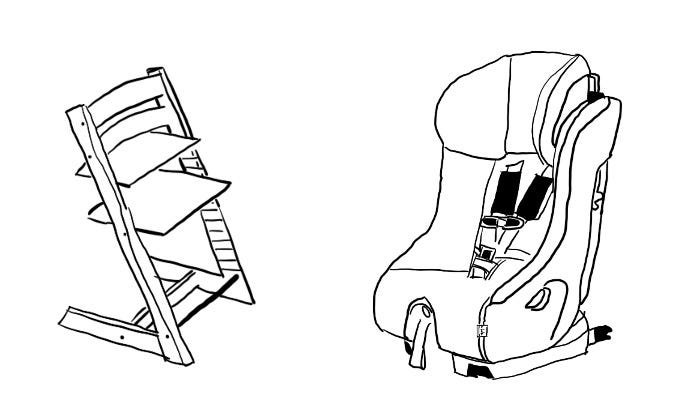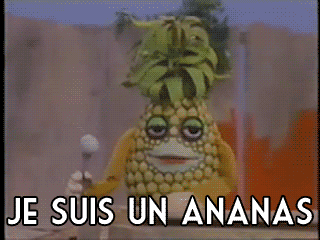Consider: Toddler Tools
Consider the children
Welcome readers! I would love to hear how you found the newsletter and what topics you’d like to see considered. Hit reply and let me know!
There are two types of items designed for toddlers. One type is geared towards the child themself, based on their unique needs, physiology and strangely-wired brains. The second are niche products based on the specific experience a parent has had (likely invented by said parent in the middle of a sleepless night). The baby mop has to to be a joke, but I am sure some people really use this 3 pack of baby bum fans to dry their children’s rears.
Sometimes though, great designers take the opportunity of designing for our littlest friends very seriously and create Considered-worthy products. Products that provide great value, sustainability, and endure over time. Two of those are the Clek Foonf car seat and the Stokke Tripp Trapp high chair.
Clek Foonf Car Seat
Full disclosure, I know Chris Lumley, Clek’s CEO and founder, through professional connections. I have abused the discount code he kindly gave me years ago by passing it along to friends and relatives, which has made me quite popular in my friend group. Discount aside, Clek stands on its own as an innovation in safety, material and product design for children.
The first car seats were more about restraining the child as opposed to protecting them. Early models were nothing more than burlap bags hung over the headrest. Next came “boosters” that were designed to allow children to see out the windshield. Fun fact: booster seats were invented before the adoption of seat belts.
At the same time, on opposite sides of the Atlantic, two separate inventors came up with the idea of the modern car seat. In England, Jean Ames (who is un-Googleable because he shares his name with a 1940s pinup model who is much more popular) came up with the rear-facing car seat. The idea being that it would be safest in the case of the car driving into something, as the baby would move in the same direction of the force of the impact (thinking that still holds true today).
In North America, Leonard Rivkin came up with the front-facing seat. Rivkin owned a children’s furniture store called Guys and Dolls in Aurora Colorado. In 1958, Rivkin and his family were rear-ended. Baby Bart flew out of his burlap bag and landed on the floor at his mother’s feet. Rivkin designed a booster seat with a five point harness, a similar design to what is sold today. He manufactured his own, selling them through his store and eventually licensed the design to Strolee, who created the “Wee Seat.” It is unclear if the name was a reference to the size of the occupant, the noise they made while driving in it, or what they likely did while sitting in it.
Interestingly, Europeans keep their children in rear-facing seats for much longer than North Americans (4 years vs 2 years). The economist Emily Oster has some great writing on best practice.
Fast forward to Clek. Chris was part of a team at Magna (an auto parts manufacturer) that started looking into booster seats, which were designed for kids who had grown out of standard children’s seats. Kids did not like to use them because they felt the seats were for “babies.” Chris and his team designed a more contemporary and stylish version that became a big hit (and was safer than a burlap bag).
Next, Chris and the team decided to tackle the infant seat. Their first seat, the Foonf, was the first child seat to have crumple zones. Crumple zones were first incorporated into car design and are the parts of the car that are designed to absorb as much of the force of an accident as possible. The Foonf includes a similar feature, directly protecting the infant. Perhaps as integral, they also recognized the challenges of having multiple car seats in one car and designed the Foonf to be narrower than most traditional car seats, allowing for three abreast in most cars.
Manufactured in Canada, Clek continues to lead by design. It is definitely a premium product, with pricing starting at $549. They even offer a merino wool option if you have a preference for natural fabrics. While car seats are not something you can purchase used (similar to helmets, etc), Clek carseats do have an industry leading 9 year expiration, which should last through most families child-rearing years.
Clek took widely available technology and manufacturing process and applied it to an oft-ignored area: car seats. In doing so, they created a whole new category and have inspired considerable innovation including the Doona, which is a car seat with wheels that can double as a stroller, and the Pico, a portable car seat that folds small and weighs less than 8 lbs. Hopefully we will continue to see more safe and interesting options on the market.
Stokke Tripp Trapp High Chair
Peter Opsvik is a big deal in the chair world. He has never been scared to think outside the box and radically re-imagine how we sit. The Hag Capisco for Flokk is more like a saddle than an office chair. The Gravy for Varier is for the bravest of sitters. With the Garden chair he reminds us that people lived in trees for longer than they have been using chairs.
Opsvik talks about working at both ends of the spectrum, “At one end, rational and ergonomic aspects are in focus; taking care of the human body’s requirements, while at the other end of the spectrum the most important criterion is expression.”
His most impressive ergonomic and design achievement is the Tripp Trapp. Originally released in 1972 (and with 12 million sold since then), Opsvik sought to design a chair that allowed his young son to participate fully at the family table. This required a chair with adjustable height and material design that did not call attention to itself. The chair is made up of two V-shaped wooden pieces joined by a pair of platforms, one that serves as a seat and the other a footrest. The flat pieces can be easily raised and lowered, adjusting to the needs of growing kids. Notably, the Tripp Trapp does not come with a tray, as is common in pretty much every other high chair on the market, allowing the child to be pulled right up to the family table.
One of the most impressive parts is Opsvik’s restraint in choice of materials. The 1970s were a time of material and manufacturing innovation. Plastics, molded plywood, etc. were all being used in furniture design. The Tripp Trapp’s original design was only four pieces of heavy wood and came in 15 colours and finishes. Stokke has since expanded the line to include accessories like harnesses and bassinets to increase the usefulness of the underlying base.
Given the sturdiness of the design, these chairs last through generations. A new one is priced in the $400s and a used model retains its value, averaging around $300. This is order of magnitude greater than the Ikea Antilop, the classic $29 (CAD) high chair and frequent fixture on curbs and in garage sales everywhere. Is the Tripp Trapp worth it? That is an individual decision. I would look at it as an actual cost of only $100 for 3-5 years of use, given how much second-hand demand there is.
What impresses me most about Clek and Stokke is their approach to children’s products. Often in this market we see disposable items that kids and parents grow out of, or damage and dispose of quickly. However, both of these products take a different approach that comes from the perspective of meeting real needs and using the same techniques and care you would use when constructing a product for an adult market.
PS
Many things for children are artfully designed for their unique needs and sensibilities. Then there is Téléfrançais!, a chaotic French language TV show that aired in Canada with the goal of teaching children French. The show featured Jacques, Sophie and Ananas (the talking pineapple). Each episode consisted of “wacky” adventures the group would have in the junkyard (where I think they lived?). The show has fuelled many nightmares in the mid-80s and beyond. I think the following Google review really says it all:









